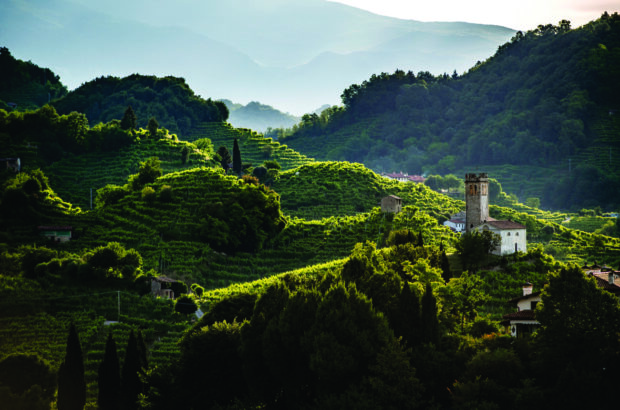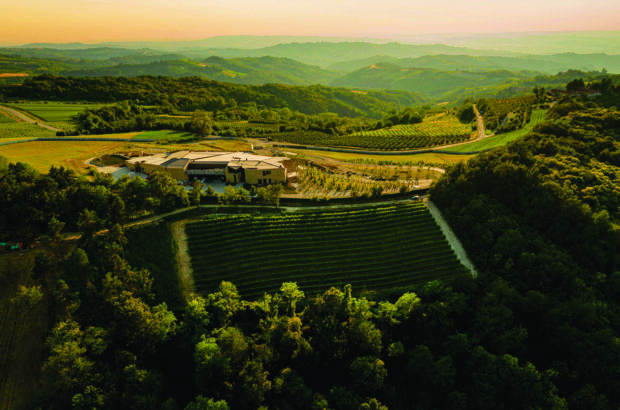We’re sitting round the table at the Pazo Señorans winery and my neighbor, the winery’s export manager Javier Izurieta Romero, passes the crab. You get a different flavor from each part of the body, the claws, the brown meat and the legs, he explains earnestly. And my goodness, he’s right. The texture, too. It’s the best crab I’ve ever eaten.
The accompaniment is the winery’s Albariño . Our hosts don’t go so far as to pair different wines with each component of the crab, but you feel they might well have done – so seriously it is seafood taken in Galicia.
It’s impossible to visit this wild, rugged coastline without gorging on it. ‘People think of Spain as sunshine and beaches, but it’s an Atlantic cuisine rather than a Mediterranean one,’ says Spanish food importer Monika Linton, author of Brindisa: The True Food of Spain . ‘It’s actually much more like Ireland or Scotland.’
The most iconic dish is octopus a la Gallega, or ‘octopus Galician-style’ (see recipe below), also known as pulpo a la feria, for which the locals have a real passion. It’s a relatively simple dish – octopus prep aside – of boiled octopus dressed with olive oil and pimenton and served with boiled potatoes.

Credit: Carol Yepes / Getty Images
Octopus has to be tenderised before you eat it, a daunting procedure that involves plunging it in and out of a cauldron of boiling water. Even the locals resort to buying it frozen.
When visiting Galicia you might also be offered percebes (prehistoric-looking barnacles that rather resemble a dinosaur’s toes), another local speciality that is perhaps more of an acquired taste – but Albariño can make pretty much anything taste good.
Other seafood dishes in Galicia that you might well find elsewhere in Spain are oysters (there is even a Rua das Ostras in Vigo), scallops – their shell the symbol of the Camino de Santiago – often served gratinated, deep fried squid, and irresistibly fat, juicy prawns (we were served them warm with alioli and cold with mayonnaise during the same meal). Not to mention the impossibly tender razor clams swimming in garlic-laced oil. Hake is a favourite for main course dishes, along with monkfish, which makes a great seafood stew. In Spain, monkfish tails are still affordable.

Abastos 2.0 (see below)
Rustic charm
Galicians are also great canners. Tinned fish is a real delicacy here, not in any way regarded as inferior to freshly caught. Go into any small wine bar, such as the Ribeira de Fefiñáns in Cambados, and you’ll find rows of colourful, beautifully designed tins that will then appear, freshly opened, as a tapa. Fast food, Galician-style.
Galicia used to be relatively poor so the food is more rustic than it is in the Basque Country, with its greater proximity to France. ‘It’s quite a traditional area – it hasn’t had the same influx of tourism as other parts of Spain, so a lot of the old traditions have been preserved,’ says Linton.
Another speciality is empanada. Not the small pasty-shaped version you find in South America, but generally cooked into a big round pie – or a thinner slice. The pastry is made with white wine then rolled out, covered with a layer of softened onion, tomato and red peppers and topped with fish, most commonly tuna but I had it with fresh sardines, which was delicious. A mussel filling is not unusual either.
It tends to be served as one of a selection of shared plates that are brought out in a seemingly never-ending succession at the beginning of a meal. Galicians are nothing if not hospitable.
Where to eat in Galicia
Although Santiago is no San Sebastián, there are an impressive number of Michelin-rated restaurants in the region, along with some fantastic, family-run seafood restaurants.
Abastos 2.0, Santiago de Compostela
Based in the market, this is a Santiago institution, serving the best of what is on offer that day. It’s small, so you’ll need to book.
Bitadorna, Vigo
Traditional seafood restaurant that focuses on the best local ingredients such as lobster, red prawns and octopus. It has another branch in A Guarda.
Casa Boveda, Pontevedra
Homely, family-style restaurant serving traditional Galician dishes, including a splendid monkfish and potato stew that’s brought bubbling to the table.
Manuel Bistró, Monforte de Lemos
A well-priced bistro serving a selection of pasta and rice dishes and an €18 midweek lunch. Popular with local winemakers.
Yayo Daporta, Cambados
Exceptionally good food for a one-star Michelin restaurant, with clever twists on the local ingredients. Opt for the tasting menu and hope it includes the deconstructed crab croqueta.

Yayo Daporta. Credit: José Luiz Oubiña
Beyond seafood
Galicia is not just coast, though. Inland, in the regions of Ribeiro, Ribeira Sacra and Monterrei you’ll find much more meat. ‘Because of the abundance of outstanding seafood, I think a lot of people forget that Galicia is also home to some of the best beef in the country,’ says Beth Willard, DWWA joint Regional Chair for Spain, who visits the region regularly. It comes from grass-fed Rubia Gallega cattle, which are typically killed at 8-12 years – yes, that’s years, not months – and the meat develops a deep, savoury, almost gamey flavour. It’s made its way into many Spanish-influenced restaurants outside the region, too.
Pork is also hugely popular. The locals consume every bit of it – the ears, snout, trotters and tail. And being Spain, naturally there’s ham as well as chorizo and other charcuterie. ‘They can’t cure it like elsewhere in the country as it’s so wet, so it tends to be brined and smoked,’ explains Linton.
Even the simplest dishes are celebrated. ‘There are more than 300 gastronomic festivals in the Galicia region, with each town having its own celebration, such as the Fiesta del Cocido in Lalín [rather endearingly translated as a Stew Fair on the website fiestapopular.com],’ says Miguel Crunia of Fìon, an Edinburgh-based wine importer who was born and bred in the region and is a mine of information on Galicia. That seems a lot, I say to him. ‘I think it’s because people don’t tend to cook so much at home any more,’ he replies.
Local staples

Caldo gallego
Given the fertility of the region, vegetables also play a big part in the local cuisine, especially potatoes (or cachelos, as they’re known locally, typically served boiled) and turnip tops (grelos). One of the much-loved staples is caldo gallego, a soup with potatoes, beans and greens that from a Spanish point of view no doubt counts as vegetarian on the grounds of only including a minor amount of pork belly or bacon, more or less as seasoning. And who knew pimientos de padrón, a staple of almost every tapas bar these days, were Galician? (They originate from the town of Padrón in La Coruña.)
‘There are a lot of small farms and allotments, still in local hands and with a real attention to quality,’ says Linton. ‘We sell the Lourenzá faba beans, for example, which are grown by a mother and daughter who only produce 300 kilos a year. They’re amazing; they taste like clotted cream.’
Speaking of dairy, in contrast to the rest of Spain, the best-known cheeses are made from cows’ rather than sheep milk. They include the smoked San Simón da Costa and mild, semi-soft Tetilla.
As elsewhere in Spain, desserts tend to be simple, based on easily available ingredients such as eggs, sugar and almonds. The most famous is the almond-based tarta de Santiago, which generally has an image of the cross of St James outlined on the icing sugar-dusted top. It’s also worth looking out for a local cheesecake called tarta de requesón, pancakes (filloas) and cream-filled cañitas, Galicia’s answer to Sicily’s cannoli (and very delicious with the local liquor, Cumbre Iberica Licore Tostada, which they serve at Casa Boveda).
‘A lot of the desserts still use chestnut flour,’ explains Linton. ‘Chestnuts were survival food for a lot of people.’
But it’s the seafood she keeps coming back to. ‘It’s the cold, rough water, the mixture of saline and fresh water that makes it so incredible. It’s not just shellfish, it’s wow shellfish!’

Eat like a Galician
The most distinctive dish in Galicia is simplicity itself – apart from the daunting task of tenderising your octopus, which is most easily done by freezing it, although the locals say it’s better when you cook it from fresh. It’s served with cachelos (potatoes), with good oil and dried pimentón completing the dish. Here’s a simple version from Monika Linton’s Brindisa: The True Food of Spain. ‘Octopus from Galicia is unbelievably good compared to what you buy elsewhere,’ she says.
Octopus Galician-style
Serves 6-8
Preparation time 10 minutes Cooking time 1 hour 10 minutes
Ingredients 2 carrots, 2 shallots, 4 peppercorns, about 400g raw, frozen octopus pieces, 200g whole baby potatoes, 1 tbsp pimentón dulce (mild paprika), 3-4 tbsp olive oil, for drizzling, pinch of sea salt (optional)
Method
1. Bring a pan of water to the boil, add the carrots, shallots and peppercorns, put in the octopus, turn down to a simmer and leave to cook gently for 40-45 minutes, until tenderised (check by pricking the chunky parts of the tentacles).
2. Lift out with a slotted spoon, and cut the tentacles into 1cm slices.
3. Reserve the pan of cooking water but discard the vegetables and peppercorns.
4. Cook the potatoes in the same water for 20-25 minutes, or until just tender, then cut in half lengthways and arrange in a serving dish with the octopus slices on top.
5. Sprinkle with the pimentón and drizzle with olive oil and a light scattering of sea salt, if you like (remember, though, that octopus will be quite salty).
Brindisa: The True Food of Spain by Monika Linton was published in September 2016 (£15 Fourth Estate)













